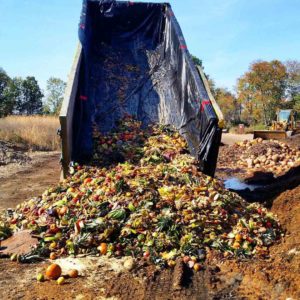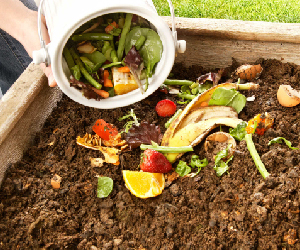Composting is currently one of the most effective ways to deal with food waste. Here we look at how it works and why waste reduction is always preferable.
Food waste in the US is a growing issue, and it is estimated that around 40 million tons is sent to landfill each year, making up around 15% of the total municipal solid waste (MSW) generated. Naturally, the huge amounts of food bought, cooked, and thrown out during the holidays has its part to play in this figure, and despite increasing calls to cut down on food waste, the amount we throw out continues to grow year-on-year.
While cutting down food waste at all stages of the journey—from farm to plate—must be the priority, inevitably, there will always be some kind of waste product related to the food we produce and consume. Thankfully, composting food waste provides us with an effective way to reuse materials in a constructive and entirely natural way.
![]()
Composting food waste — The basics
In simple terms, the composting process recycles organic materials into a hummus-like substance that can be used as a soil conditioner. Almost everyone is familiar with compost in one way or another—whether that’s the compost pile at the bottom of the garden or a bag of potting material used for house plants. However, the fundamental processes behind compost are less familiar, and worth understanding in the context of food waste.

Composting is an aerobic process (exposed to the air), which stands in contrast to anaerobic fermentation (air exposure is minimized), both of which can be used to turn food waste and other organic inputs, such as garden waste, into compost. For conventional composting to work effectively, four elements are required; carbon, nitrogen, oxygen, and water. This means balancing food waste (greens = nitrogen rich) with inputs such as dry leaves or woody debris (browns = carbon rich) will always produce the highest quality compost.
When these elements are present, microorganisms work to break down the waste and render it inert, killing any pathogens that may present a danger to humans. These microorganisms include bacteria, actinobacteria, fungi, molds, yeast, protozoa, and rotifers, each of which plays an integral part in converting food waste to compost.
While composting effectively removes food waste from landfill, reducing waste should always be the first step. Reduction is the best way to deal with food waste at all stages of the production chain, not only minimizing waste at the end of the chain, but also conserving resources at production level, such as land, water, and the carbon footprint associated with farming.
For what may be termed “true food waste”—the inedible parts of a plant or animal for instance—composting is among the cheapest and most effective methods of recycling.
![]()
Composting food waste at home
There are many ways to compost at home, and you don’t necessarily need a garden to do it. Broadly speaking, composting and fermentation methods can be split into the following:
Standard Composting
This method piles up layers of waste, killing pathogens and slowly composting organic material. Generally, meat, fish, dairy, and oils are difficult to compost at home, while other materials such as citrus and onion peels may also be problematic. This is because temperatures may not reach the required levels to breakdown such waste in smaller piles, and the potential to attract rodents and other pests may also be an issue. However, this method requires little maintenance and expense to set up in a garden or other outdoor space.
Vermicomposting
Uses various species of worm to help break down waste. It can be practiced in confined spaces with dedicated vermicomposting bins. Animal-based materials such as meat or dairy may be problematic as they attract rodents, however, vermicomposting can deal with small amounts of these materials, and as long as your bin is safely stowed away, the pest problem shouldn’t be an issue.
Bokashi
Uses effective microorganisms to ferment waste in an anaerobic container. Capable of “composting” all types of waste which can then be used within a soil factory or added to a conventional compost heap where it breaks down more quickly than when using conventional methods. Additionally, this type of “composting” can be practiced indoors, as the sealed containers do not attract pests and do not release odors.
![]()
Composting food waste commercially

In many ways, commercial composting can be considered simply as a large-scale version of conventional home or farm composting. Most methods follow the same aerobic processes as found in a standard compost pile. Unlike smaller piles, however, the heat generated within commercial-scale piles is usually sufficient to compost food waste of any kind—including meat and dairy products.
Commercial composting uses methods such as in-vessel composting, aerated static pile composting, vermicomposting, or windrow composting, with the method used dependent on factors such as available space and the amount of material to be composted. Commercial sites can produce huge amounts of compost which can then be sold back to consumers or to farmers.
![]()
Overcoming the perceived challenges of composting food waste
While composting is currently the most efficient way to deal with true food waste, separating unused food into a dedicated container or organics bin can present challenges without proper disposal options. Commercial facilities, in particular, must deal with numerous logistics surrounding the collection of food waste for composting and the management of disposal.

Waste stream contamination is the biggest factor in inhibiting successful organics recycling, and while in theory, commercial-composting facilities can deal with all types of food waste, in reality, this is not always the case. If non-organic materials end up in organics bins, these need to be removed (usually by hand) before being added to the compost pile. The same may be true for meat, fish, or dairy products. The only other option is to simply write-off the waste as landfill. Proper training and education programs for operations staff, such as kitchen and janitorial services, are an excellent way to facilitate cleaner waste streams and to set up an effective composting program.
For more information on commercial food waste management and composting, contact RTS today. We will be happy to help your business reduce, donate, and compost food waste in the most efficient and effective ways possible.




